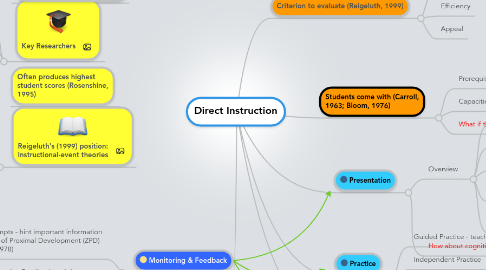Direct Instruction
создатель Tom Johnson


1. Key Researchers
1.1. William Huitt
1.2. David Monetti
1.3. John Hummel
2. Often produces highest student scores (Rosenshine, 1995)
3. Reigeluth's (1999) position: Instructional-event theories
3.1. Improve student learning
3.2. Inform practitioner methods to employ
3.3. Improve likelihood that desired outcomes will occur
4. Monitoring & Feedback
4.1. Cues & Prompts - hint important information called Zone of Proximal Development (ZPD) (Vygotsky, 1978)
4.1.1. Good point
4.2. Corrective Feedback - reinforcement for both correct and incorrect responses
5. (JOHNSON, T., 2013)
6. Criterion to evaluate (Reigeluth, 1999)
6.1. Effectiveness
6.2. Efficiency
6.3. Appeal
7. Presentation
7.1. Overview
7.1.1. Review - previous material or prerequisite skill
7.1.2. What - knowledge or skill
7.1.3. Why - objectives are important
7.1.4. Explanation - of knowledge or skill to be learned
7.1.5. Probe & Respond - multiple opportunities for students
